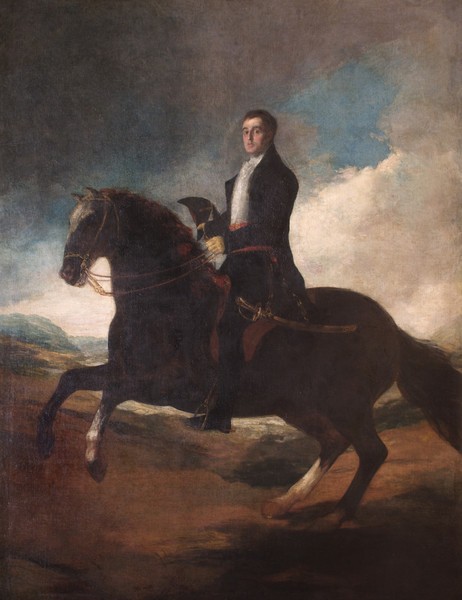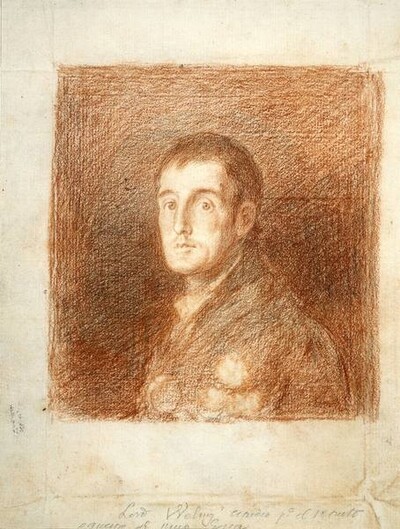- Cronología
- 1812
- Ubicación
- Apsley House, London, United Kingdom
- Dimensiones
- 294 x 240 cm
- Técnica y soporte
- Oil on canvas
- Reconocimiento de la autoría de Goya
- Documented work
- Titular
- Wellington Museum
- Ficha: realización/revisión
- 18 Apr 2010 / 16 Jun 2023
According to the inscription found on a preparatory drawing of the Duke of Wellington, in pencil and sanguine and now in the collection of the British Museum, this work was produced whilst the Duke of Wellington was staying in Madrid, and was made for the Royal Academy of Fine Arts of San Fernando. In 1812, in the issue of the Diario de Madrid newspaper dated 1 September, an advertisement declared that, for a few days, the rooms of the main wing of the Royal Academy would be opened up to the public, and that in one of these rooms Goya's portrait of the Duke of Wellington was hanging.
Today, this same painting hangs on a wall in Apsley House, London.
There was a rumour that, whilst Goya was making the portrait or the preparatory studies for it in the presence of his model, the two men had an argument. This appears to have been little more than a romantic tale, however, derived from the fact that, whilst the painter was in the company of Wellington, the duke received a visit from Sir James McGrigor, the head of the Staff Medical Services, whom he violently recriminated for providing certain medical treatment to the wounded during combat.
Lord Arthur Wellesley, Duke of Wellington (1769-1852), was an English general who commanded the British troops fighting in Spain against Napolean's forces during the Spanish War of Independence. On 22 July 1812 he won a decisive battle at Arapiles, prior to the liberation of Madrid.
This life-size portrait depicts the Duke of Wellington mounted on a horse, which is rearing up on its hind legs. He is shown wearing a dark civilian riding outfit, white shirt and red sash. In his right hand he is holding his hat, whilst holding his horse's reins in the other. Sitting very upright on the horse, he looks straight out at the viewer in a pose identical to that in the pencil and sanguine drawing made that same year. This portrait was painted on a canvas on which another equestrian portrait had been painted before. It has been suggested that the identity of the original subject was Manuel Godoy or Joseph Bonaparte. It is very possible that Goya produced this more recent painting by referring to the small bust portrait that he painted earlier, and which is now located in the National Gallery, London, and the drawing of the same subject.
For further biographical information The Duke of Wellington.
-
Loan exhibition of Painting by El Greco and GoyaM. Knoedler and Co.New York1912April 1912cat. 18
-
Goya and his timesThe Royal Academy of ArtsLondon1963cat. 66cat. 105
-
L'œuvre peint de Goya. 4 volsParís1928-1950p. 189, cat. 476
-
Vie et ouvre de Francisco de GoyaParísOffice du livre1970
-
BarcelonaPolígrafa1970vol. I, p. 344, cat. 557
-
Francisco de Goya, 4 vols.ZaragozaCaja de Ahorros de Zaragoza, Aragón y Rioja1980-1982vol. III, p. 198
-
DiplomatarioZaragozaInstitución Fernando el Católico1981p. 367
-
Goya en tiempos de guerraMadridMuseo Nacional del Prado2008p. 275 y 278 (il.)


